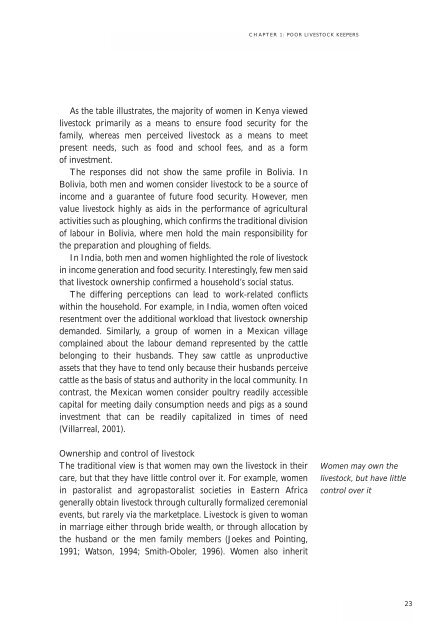Livestock Services and the Poor: A global initiative - IFAD
Livestock Services and the Poor: A global initiative - IFAD
Livestock Services and the Poor: A global initiative - IFAD
Create successful ePaper yourself
Turn your PDF publications into a flip-book with our unique Google optimized e-Paper software.
CHAPTER 1: POOR LIVESTOCK KEEPERS<br />
As <strong>the</strong> table illustrates, <strong>the</strong> majority of women in Kenya viewed<br />
livestock primarily as a means to ensure food security for <strong>the</strong><br />
family, whereas men perceived livestock as a means to meet<br />
present needs, such as food <strong>and</strong> school fees, <strong>and</strong> as a form<br />
of investment.<br />
The responses did not show <strong>the</strong> same profile in Bolivia. In<br />
Bolivia, both men <strong>and</strong> women consider livestock to be a source of<br />
income <strong>and</strong> a guarantee of future food security. However, men<br />
value livestock highly as aids in <strong>the</strong> performance of agricultural<br />
activities such as ploughing, which confirms <strong>the</strong> traditional division<br />
of labour in Bolivia, where men hold <strong>the</strong> main responsibility for<br />
<strong>the</strong> preparation <strong>and</strong> ploughing of fields.<br />
In India, both men <strong>and</strong> women highlighted <strong>the</strong> role of livestock<br />
in income generation <strong>and</strong> food security. Interestingly, few men said<br />
that livestock ownership confirmed a household’s social status.<br />
The differing perceptions can lead to work-related conflicts<br />
within <strong>the</strong> household. For example, in India, women often voiced<br />
resentment over <strong>the</strong> additional workload that livestock ownership<br />
dem<strong>and</strong>ed. Similarly, a group of women in a Mexican village<br />
complained about <strong>the</strong> labour dem<strong>and</strong> represented by <strong>the</strong> cattle<br />
belonging to <strong>the</strong>ir husb<strong>and</strong>s. They saw cattle as unproductive<br />
assets that <strong>the</strong>y have to tend only because <strong>the</strong>ir husb<strong>and</strong>s perceive<br />
cattle as <strong>the</strong> basis of status <strong>and</strong> authority in <strong>the</strong> local community. In<br />
contrast, <strong>the</strong> Mexican women consider poultry readily accessible<br />
capital for meeting daily consumption needs <strong>and</strong> pigs as a sound<br />
investment that can be readily capitalized in times of need<br />
(Villarreal, 2001).<br />
Ownership <strong>and</strong> control of livestock<br />
The traditional view is that women may own <strong>the</strong> livestock in <strong>the</strong>ir<br />
care, but that <strong>the</strong>y have little control over it. For example, women<br />
in pastoralist <strong>and</strong> agropastoralist societies in Eastern Africa<br />
generally obtain livestock through culturally formalized ceremonial<br />
events, but rarely via <strong>the</strong> marketplace. <strong>Livestock</strong> is given to woman<br />
in marriage ei<strong>the</strong>r through bride wealth, or through allocation by<br />
<strong>the</strong> husb<strong>and</strong> or <strong>the</strong> men family members (Joekes <strong>and</strong> Pointing,<br />
1991; Watson, 1994; Smith-Oboler, 1996). Women also inherit<br />
Women may own <strong>the</strong><br />
livestock, but have little<br />
control over it<br />
23

















